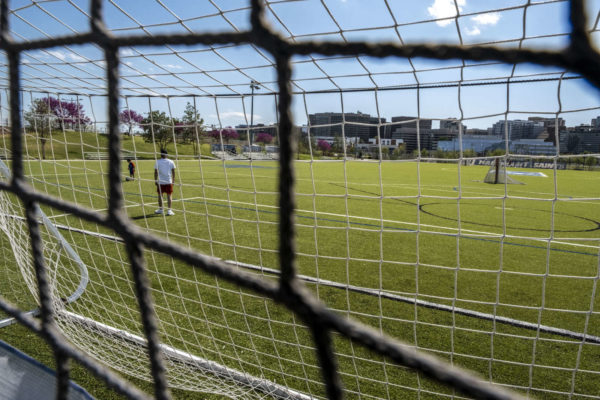Arlington County is asking residents how and when they use athletic fields.
The County’s Public Spaces Master Plan, adopted in April 2019, calls for a public survey every five years to garner feedback to determine how and when Arlingtonians use the available athletic fields.
The collected data will be used to update the permit process, availability of fields, and who has access when.
“We have a finite amount of park spaces,” Jerry Solomon, Community Engagement Manager for the Department of Parks and Recreation, writes to ARLnow in an email. “Our goal is to ensure we are using them as efficiently and effectively as possible. We need to determine if we are offering field spaces at times that people can best access them.”
Fields for adult soccer leagues, for example, are most needed outside of typical working hours. Baseball diamonds for Little League should be accessible when the players are, like on weekends or after school.
This survey will help make sure this is the case, plus provide additional data that may not be as self-explanatory.
The survey specifically asks about activity start and end times for different age groups as well, like if kids 9 and youngers should end their field use prior sundown on weekdays and who should have access to lighted fields.
In total, Arlington has 96 athletic fields — a mix of rectangular fields (35), diamond fields (42), and a combination of the two (19). That can be further broken down into lighted (37) and not lighted fields (59) as well as natural grass (80) and synthetic turf fields (16).
It probably doesn’t come as a surprise that the fields that have the most use on an individual basis are the lighted, synthetic turf fields. On average, each one of those fields gets more than 2,100 hours of play per year. This is compared to an average of 700 hours per non-lighted, natural grass field.
For years, which fields got lights has been a source of community contention.
Athletic field use in Arlington is often not a free-for-all or on a first-come, first-serve basis. Nearly all of the fields are either only accessible to permit holders or priority is given to permit holders.
Only six of the 96 athletic fields in Arlington are available as drop-in fields, or “community fields.” Even those, though, can be reserved for scheduled programs or practices.
That has drawn the ire of some residents, like those who live near Pentagon City and want to see one or both of the softball diamonds at Virginia Highlands Park opened up for community use.
There’s even a tiered priority system for the allocation of permits, which was first recommended in 2016 due to an “inequity” that existed in how fields were allocated.
Arlington Public Schools are given first priority, then county-organized non-profit youth sport leagues, then adult leagues, then for-profit sports leagues, and, finally, individual rentals or other organizations.
Some fields also have agreements with local universities for their use.
All of this, plus Arlington’s growing population, is resulting in heavy use and demand for athletic fields. According to the PSMP, the county could need an additional 11 rectangular and 2 diamond fields by 2035 to maintain the current levels of use and access.
The hope is that the survey and public feedback will allow for better, more efficient, and more fair use of the limited field space.
This survey will be open until the end of the month, says Solomon, at which point DPR will review and report findings to the Public Spaces Master Plan Implementation Committee in the spring.
There could be more opportunities to provide feedback come the spring and summer, Solomon noted.


